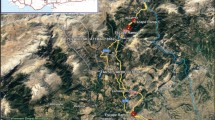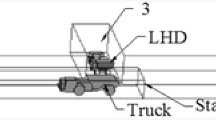Abstract
Although there are many studies involving influence of runaway truck entry speed and longitudinal grade on stopping distance, focusing on aggregate properties is scarce. This paper investigates the influence of the aggregate properties such as types of aggregate and river gravel radius on stopping distance through numerical analysis of particle flow code in two dimensions (PFC2D). The software is used to generate stopping distance data for two aggregate types and four group gravel radii under various approaching speeds and grades. The generated data are compared with the testing results of full-scale arrester bed. The simulated finding of this paper implies that types of aggregates and river gravel radii have a significant impact on the stopping distance for runaway truck on escape ramps.
Similar content being viewed by others
References
ECK R W. Development of warrants for the use and location of truck escape ramps. Volume I: Final report [R]. Morgantown, USA: West Virgina University, 1980.
ECK R W. Development of warrants for the use and location of truck escape ramps. Volume II: Appendices [R]. Morgantown, USA: West Virgina University, 1980.
OUTCALT W. Evaluation of truck arrester beds in Colorado [R]. Denver, USA: Colorado Department of Transportation, 2008.
ZHANG J J, ZHANG G Q. Analysis of incidents in emergency escape ramps and legal risk aversion [C]//Proceedings of the 4th International Conference on Transportation Engineering. Chengdu, China: ICTE, 2013: 706–715.
WASHNOCK R J. The design of a facility and the testing methodology to measure the drag on a rolling tire through gravel [D]. State College, USA: Mechanical Engineering Department, the Pennsylvania State University, 1984.
American Association of State Highway and Transportation Officials (AASHTO). A policy on geometric design of highway and streets: GDSH-6-E1 [S]. Washington, USA: AASHTO, 2013.
LIN D Y. Study on the design of truck escape ramps of Fu-yin expressway in long downhill section [J]. Fujian Jiaotong Keji, 2016(3): 107–109 (in Chinese).
MENG Z H. Design method of truck escape ramps of mountainous expressway [J]. Journal of Highway and Transportation Research and Development (Application Technical Edition), 2016, 12(5): 304–306 (in Chinese).
YUAN Z Y. The study on length of emergency escape ramp in mountain road [D]. Xi’an, China: College of Highway, Chang’an University, 2006 (in Chinese).
QIAN Y S, ZHOU B, CHENG Y H, et al. Mechanism and experimental analysis of a class of decelerating downhill lanes [J]. Journal of China & Foreign Highway, 2007, 27(4): 5–8 (in Chinese).
YANG Y Z. Study on aggregate resistance coefficient of emergency escape ramp [J]. Transport Engineering, 2015(8): 86–88 (in Chinese).
WAMBOLD J C. Truck escape ramp design methodology. Volume I: Executive Summary [R]. State College, USA: The Pennsylvania State University, 1988.
WAMBOLD J C, RIVERA-ORTIZ L A, WANG M C, et al. A field and laboratory study to establish truck escape ramp design methodology. Volume II [R]. State College, USA: The Pennsylvania State University, 1988.
AL-QADI I L, RIVERA-ORTIZ L A. Laboratory testing of river gravel used in arrester beds [J]. Journal of Testing and Materials, 1991, 19(4): 280–291.
AL-QADI I L, RIVERA-ORTIZ L A. Use of gravel properties to develop arrester bed stopping model [J]. Journal of Transportation Engineering, 1991, 117(5): 566–584.
ITASCA Consulting Group. PFC Theory and background (online manual table of contents) [R]. Minnesota, USA: ITASCA, 2014.
The Arizona Department of Transportation. Full-scale arrester bed testing leads to more cost-effective design [J]. Transportation Research News, 1993, 166: 20–21.
TRITSCH S L. A review of truck escape ramps for HPR-PL-1(31)280: Evaluation of arrester bed performance [R]. Phoenix, USA: Arizona Department of Transportation, 1987.
BEKKER M G. Introduction to terrain-vehicle systems [M]. Michigan, USA: The University of Michigan Press, 1969.
WILLIAMS E C. Emergency escape ramps for runaway heavy vehicles (EERRHV): Final report [R]. Michigan, USA: The University of Michigan, 1978.
Author information
Authors and Affiliations
Corresponding author
Additional information
Foundation item: the Guangxi Natural Science Found (No. 2015GXNSFAA139280)
Rights and permissions
About this article
Cite this article
Qin, P., Chen, C., Guo, H. et al. Analyzing the Influence of Aggregate Properties on Stopping Distance on Truck Escape Ramps. J. Shanghai Jiaotong Univ. (Sci.) 24, 323–327 (2019). https://doi.org/10.1007/s12204-019-2062-x
Received:
Published:
Issue Date:
DOI: https://doi.org/10.1007/s12204-019-2062-x




